Removal of Nitrogen and Phosphorus in Low Polluted Wastewater by Aquatic Plants: Impact of Monochromatic Light Radiation
Abstract
:1. Introduction
2. Materials and Methods
2.1. Experimental Water Quality Preparation
2.2. Experimental Design
3. Results
4. Discussion
4.1. Growth of Aquatic Plants under Different Light
4.2. Removal Efficiencies of N/P under Different Light
4.3. Application Prospect
5. Conclusions
Author Contributions
Funding
Data Availability Statement
Acknowledgments
Conflicts of Interest
References
- Bradford-Hartke, Z.; Lane, J.; Lant, P.; Leslie, G. Environmental benefits and burdens of phosphorus recovery from municipal wastewater. Environ. Sci. Technol. 2015, 49, 8611–8622. [Google Scholar] [CrossRef] [PubMed]
- Rashid, S.S.; Liu, Y.Q.; Zhang, C. Upgrading a large and centralised municipal wastewater treatment plant with sequencing batch reactor technology for integrated nutrient removal and phosphorus recovery: Environmental and economic life cycle performance. Sci. Total Environ. 2020, 749, 141465. [Google Scholar] [CrossRef] [PubMed]
- Lu, Z.N.; Chen, H.Y.; Hao, Y.; Wang, J.Y.; Song, X.J.; Mok, T.M. The dynamic relationship between environmental pollution, economic development and public health: Evidence from China. J. Clean. Prod. 2017, 166, 134–147. [Google Scholar] [CrossRef]
- Liu, Y.S.; Ying, G.G.; Shareef, A.; Kookana, R.S. Occurrence and removal of benzotriazoles and ultraviolet filters in a municipal wastewater treatment plant. Environ. Pollut. 2012, 165, 225–232. [Google Scholar] [CrossRef]
- Chadha, U.; Selvaraj, S.K.; Thanu, S.V.; Cholapadath, V.; Abraham, A.M.; Manoharan, M.; Paramsivam, V. A review of the function of using carbon nanomaterials in membrane filtration for contaminant removal from wastewater. Mater. Res. Express 2022, 9, 012003. [Google Scholar] [CrossRef]
- GB 18918-2002; China-NEPA, Discharge Standard of Pollutants for Municipal Wastewater Treatment Plant. China Environmental Science Press: Beijing, China, 2002.
- GB 3838-2002; China-NEPA, Surface Water Environmental Quality Standard. China Environmental Science Press: Beijing, China, 2002.
- Wang, H.X.; Xu, J.L.; Sheng, L.X.; Teng, H.W. Study on treatment of city tail water by constructed wetland with corn straw biochar substrate. Environ. Technol. Inno. 2022, 28, 102855. [Google Scholar] [CrossRef]
- Wu, S.B.; Vymazal, J.; Brix, H. Critical review: Biogeochemical networking of Iron in constructed wetlands for wastewater treatment. Environ. Sci. Technol. 2019, 53, 7930–7944. [Google Scholar]
- Fan, Y.Y.; Sun, S.S.; He, S.B. Iron plaque formation and its effect on key elements cycling in constructed wetlands: Functions and outlooks. Water Res. 2023, 235, 119837. [Google Scholar] [CrossRef] [PubMed]
- Chen, S.Q.; Chu, Z.S. Purification efficiency of nitrogen and phosphorus in Ottelia acuminata on four kinds of simulated sewage. Ecol. Eng. 2016, 93, 159–165. [Google Scholar] [CrossRef]
- Xu, J.; Liu, J.; Hu, J.; Wang, H.; Sheng, L.; Dong, X.; Jiang, X. Nitrogen and phosphorus removal in simulated wastewater by two aquatic plants. Environ. Sci. Pollut. R. 2021, 28, 63237–63249. [Google Scholar] [CrossRef]
- Minuti, G.; Coetzee, J.A.; Ngxande-Koza, S.; Hill, M.P.; Stiers, I. Prospects for the biological control of Iris pseudacorus L. (Iridaceae). Biocontrol. Sci. Techn. 2021, 31, 314–335. [Google Scholar] [CrossRef]
- Crișan, I.; Vidican, R.; Morea, A.; Simea, Ș. Dyeing potential of linen fabric with Iris flower extracts. ProEnvironment 2018, 11, 36. [Google Scholar]
- Leiva, A.M.; Núñez, R.; Gómez, G.; López, D.; Vidal, G. Performance of ornamental plants in monoculture and polyculture horizontal subsurface flow constructed wetlands for treating wastewater. Ecol. Eng. 2018, 120, 116–125. [Google Scholar] [CrossRef]
- Zurita, F.; De Anda, J.; Belmont, M.A. Treatment of domestic wastewater and production of commercial flowers in vertical and horizontal subsurface-flow constructed wetlands. Ecol. Eng. 2009, 35, 861–869. [Google Scholar] [CrossRef]
- Pan, X.; Ping, Y.; Cui, L.; Zhang, X.; Li, W.; Hu, Y.; Cornelissen, J.H.C. Nutrient resorption from leaves of wetland plants in a constructed wetland depends on green leaf nutrient content and life form. Wetlands 2020, 40, 983–991. [Google Scholar] [CrossRef]
- Zhang, J.; Wen, C.; Chen, M.; Gu, J.; Zhou, J.; Duan, Y.; Zhang, H.; Ma, H. Antioxidant activities of Sagittaria sagittifolia L. polysaccharides with subcritical water extraction. Int. J. Biol. Macromol. 2019, 134, 172–179. [Google Scholar] [CrossRef] [PubMed]
- Carrillo, V.; Gómez, G.; Vidal, G. Phosphorus uptake by macrophyte plants in monocultures and polycultures in constructed wetlands for wastewater treatment. Ecol. Eng. 2022, 182, 106690. [Google Scholar] [CrossRef]
- Han, W.; Ge, Y.; Ren, Y.; Luo, B.; Du, Y.; Chang, J.; Wu, J. Removal of metals and their pools in plant in response to plant diversity in microcosms of floating constructed wetlands. Ecol. Eng. 2018, 113, 65–73. [Google Scholar] [CrossRef]
- Tang, X.; Liu, H.; Naïla, R.S.L.; Dai, Y.; Zhang, X.; Tam, N.F.-y.; Xiong, C.; Yang, Y. Irrigation using hybrid constructed wetland treated domestic sewage: Uptake of phthalic acid esters and antibiotics by Ipomoea aquatica forssk. J. Hazard. Mater. 2021, 405, 124025. [Google Scholar] [CrossRef]
- Gao, J.; Yang, L.; Zhong, R.; Chen, Y.; Zhang, J.; Gao, J.; Cai, M.; Zhang, J. Comparison of nitrogen and phosphorus removal efficiency between two types of baffled vertical flow constructed wetlands planted with Oenanthe javanica. Water Sci. Technol. 2020, 81, 2023–2032. [Google Scholar] [CrossRef]
- Endut, A.; Lananan, F.; Abdul Hamid, S.H.; Jusoh, A.; Wan Nik, W.N. Balancing of nutrient uptake by water spinach (Ipomoea aquatica) and mustard green (Brassica juncea) with nutrient production by African catfish (Clarias gariepinus) in scaling aquaponic recirculation system. Desalin. Water Treat. 2016, 57, 29531–29540. [Google Scholar] [CrossRef]
- Batista, D.S.; de Castro, K.M.; da Silva, A.R.; Teixeira, M.L.; Sales, T.A.; Soares, L.I.; das Graças Cardoso, M.; de Oliveira Santos, M.; Viccini, L.F.; Otoni, W.C. Light quality affects in vitro growth and essential oil profile in Lippia alba (Verbenaceae). Vitr. Cell. Dev. Biol.-Plant 2016, 52, 276–282. [Google Scholar] [CrossRef]
- Yadav, A.; Singh, D.; Lingwan, M.; Yadukrishnan, P.; Masakapalli, S.K.; Datta, S. Light signaling and UV-B-mediated plant growth regulation. J. Integr. Plant. Biol. 2020, 62, 1270–1292. [Google Scholar] [CrossRef] [PubMed]
- Lazzarin, M.; Meisenburg, M.; Meijer, D.; Van Ieperen, W.; Marcelis, L.; Kappers, I.; Van der Krol, A.; van Loon, J.; Dicke, M. LEDs make it resilient: Effects on plant growth and defense. Trends Plant Sci. 2021, 26, 496–508. [Google Scholar] [CrossRef] [PubMed]
- Hogewoning, S.W.; Trouwborst, G.; Maljaars, H.; Poorter, H.; van Ieperen, W.; Harbinson, J. Blue light dose–responses of leaf photosynthesis, morphology, and chemical composition of Cucumis sativus grown under different combinations of red and blue light. J. Exp. Bot. 2010, 61, 3107–3117. [Google Scholar] [CrossRef] [PubMed]
- Samuolienė, G.; Viršilė, A.; Brazaitytė, A.; Jankauskienė, J.; Sakalauskienė, S.; Vaštakaitė, V.; Novičkovas, A.; Viškelienė, A.; Sasnauskas, A.; Duchovskis, P. Blue light dosage affects carotenoids and tocopherols in microgreens. Food Chem. 2017, 228, 50–56. [Google Scholar] [CrossRef] [PubMed]
- Ji, Y.; Ouzounis, T.; Courbier, S.; Kaiser, E.; Nguyen, P.T.; Schouten, H.J.; Visser, R.G.F.; Pierik, R.; Marcelis, L.F.M.; Heuvelink, E. Far-red radiation increases dry mass partitioning to fruits but reduces Botrytis cinerea resistance in tomato. Environ. Exp. Bot. 2019, 168, 103889. [Google Scholar] [CrossRef]
- Baba, M.; Kikuta, F.; Suzuki, I.; Watanabe, M.M.; Shiraiwa, Y. Wavelength specificity of growth, photosynthesis, and hydrocarbon production in the oil-producing green alga Botryococcus braunii. Bioresour. Technol. 2012, 109, 266–270. [Google Scholar] [CrossRef] [PubMed]
- Johkan, M.; Shoji, K.; Goto, F.; Hahida, S.; Yoshihara, T. Effect of green light wavelength and intensity on photomorphogenesis and photosynthesis in Lactuca sativa. Environ. Exp. Bot. 2012, 75, 128–133. [Google Scholar] [CrossRef]
- Song, N.; Jiang, H.L. Coordinated photodegradation and biodegradation of organic matter from macrophyte litter in shallow lake water: Dual role of solar irradiation. Water Res. 2020, 172, 115516. [Google Scholar] [CrossRef]
- Binhe, G. Phosphorus removal in small constructed wetlands dominated by submersed aquatic vegetation in South Florida, USA. J. Plant Ecol. 2008, 1, 67–74. [Google Scholar]
- Soares, M.B.; de Mello Prado, R.; Tenesaca, L.F.L.; Lúcio, J.C.B.; Carvalho, R.F. Tomato phytochromes B1 and B2 are part of the responses to the nutritional stress induced by NPK deficiency. Physiol. Plant. 2021, 173, 2238–2247. [Google Scholar] [CrossRef] [PubMed]
- Cao, X.; Zhao, Y.; Xia, R.X.; Wu, Q.S.; Hashem, A.; Abd_Allah, E.F. Interactions between Root Hair Development and Arbuscular Mycorrhizal Fungal Colonization in Trifoliate Orange Seedlings in Response to P Levels. Agriculture 2024, 14, 763. [Google Scholar] [CrossRef]
- Winkler, M.K.H.; Straka, L. New directions in biological nitrogen removal and recovery from wastewater. Curr. Opin. Biotech. 2019, 57, 50–55. [Google Scholar] [CrossRef] [PubMed]
- Zhou, X.H.; Wang, G.X.; Yang, F. Characteristics of growth, nutrient uptake, purification effect of Ipomoea aquatica, Lolium multiflorum, and Sorghum sudanense grown under different nitrogen levels. Desalination 2011, 273, 366–374. [Google Scholar] [CrossRef]
- Hosseinzadeh, S.; Verheust, Y.; Bonarrigo, G.; Van Hulle, S. Closed hydroponic systems: Operational parameters, root exudates occurrence and related water treatment. Rev. Environ. Sci. Bio. 2017, 16, 59–79. [Google Scholar] [CrossRef]
- Zhou, Q.; Sun, H.M.; Jia, L.X.; Wu, W.Z.; Wang, J.L. Simultaneous biological removal of nitrogen and phosphorus from secondary effluent of wastewater treatment plants by advanced treatment: A review. Chemosphere 2022, 296, 134054. [Google Scholar] [CrossRef] [PubMed]
- Colzi, I.; Renna, L.; Bianchi, E.; Castellani, M.B.; Coppi, A.; Pignattelli, S.; Loppi, S.; Gonnelli, C. Impact of microplastics on growth, photosynthesis and essential elements in Cucurbita pepo L. J. Hazard. Mater. 2022, 423, 127238. [Google Scholar] [CrossRef] [PubMed]
- Rahman, M.H.U.; Fahad, S.; Saleem, M.H.; Hafeez, M.; Deng, G. Red light optimized physiological traits and enhanced the growth of ramie (Boehmeria nivea L.). Photosynthetica 2020, 58, 922–931. [Google Scholar] [CrossRef]
- Baidya, A.; Akter, T.; Islam, M.R.; Shah, A.; Hossain, M.A.; Salam, M.A.; Paul, S.I. Effect of different wavelengths of LED light on the growth, chlorophyll, β-carotene content and proximate composition of Chlorella ellipsoidea. Heliyon 2021, 7, e08525. [Google Scholar] [CrossRef]
- Moradi, S.; Kafi, M.; Aliniaeifard, S.; Salami, S.A.; Shokrpour, M.; Pedersen, C.; Moosavi-Nezhad, M.; Wróbel, J.; Kalaji, H.M. Blue light improves photosynthetic performance and biomass partitioning toward harvestable organs in saffron (Crocus sativus L.). Cells 2021, 10, 1994. [Google Scholar] [CrossRef] [PubMed]
- Johnson, R.E.; Kong, Y.; Zheng, Y. Elongation growth mediated by blue light varies with light intensities and plant species: A comparison with red light in arugula and mustard seedlings. Environ. Exp. Bot. 2020, 169, 103898. [Google Scholar] [CrossRef]
- Lu, B.; Xu, Z.S.; Li, J.G.; Chai, X.L. Removal of water nutrients by different aquatic plant species: An alternative way to remediate polluted rural rivers. Ecol. Eng. 2018, 110, 18–26. [Google Scholar] [CrossRef]
- Neumann, G.; Bott, S.; Ohler, M.A.; Mock, H.P.; Lippmann, R.; Grosch, R.; Smalla, K. Root exudation and root development of lettuce (Lactuca sativa L. cv. Tizian) as affected by different soils. Front. Microbiol. 2014, 5, 2. [Google Scholar] [CrossRef] [PubMed]
- Xu, J.; Guo, Z.X.; Jiang, X.C.; Ahammed, G.J.; Zhou, Y.H. Light regulation of horticultural crop nutrient uptake and utilization. Hortic. Plant J. 2021, 7, 367–379. [Google Scholar] [CrossRef]
- Bucci, P.; Coppotelli, B.; Morelli, I.; Zaritzky, N.; Caravelli, A. Micronutrients and COD/N ratio as factors influencing granular size and SND in aerobic granular sequencing batch reactors operated at low organic loading. J. Water Process Eng. 2022, 46, 102625. [Google Scholar] [CrossRef]
- Chen, D.H.; Li, H.B.; Xue, X.F.; Zhang, L.L.; Hou, Y.N.; Chen, H.; Zhang, Y.S.; Song, Y.D.; Zhao, S.Q.; Guo, J.B. Enhanced simultaneous partial nitrification and denitrification performance of aerobic granular sludge via tapered aeration in sequencing batch reactor for treating low strength and low COD/TN ratio municipal wastewater. Environ. Res. 2022, 209, 112743. [Google Scholar] [CrossRef] [PubMed]
- Wang, S.M.; Jin, Z.Y.; Chen, Z.H.; Zheng, Z.; Li, L.L.; Ding, X.F.; Zhang, C.C.; Lv, G.J. Effect of light wavelengths on algal-bacterial symbiotic particles (ABSP): Nitrogen removal, physicochemical properties, community structure. J. Clean. Prod. 2023, 429, 139465. [Google Scholar] [CrossRef]
- Wang, S.; Liu, X.; Liu, X.; Xue, J.; Ren, X.; Zhai, Y.; Zhang, X. The red/blue light ratios from light-emitting diodes affect growth and flower quality of hippeastrum hybridum ‘red lion’. Front. Plant Sci. 2022, 13, 1048770. [Google Scholar] [CrossRef]
- Zhang, Y.; Kaiser, E.; Zhang, Y.; Yang, Q.; Li, T. Red/blue light ratio strongly affects steady-state photosynthesis, but hardly affects photosynthetic induction in tomato (Solanum lycopersicum). Physiol. Plant. 2019, 167, 144–158. [Google Scholar] [CrossRef]
- Wedchaparn, O.; Ayisi, C.L.; Huo, Y.Z.; He, P.M.; Road, H. Effects of different light intensity fluctuations on growth rate, nutrient uptake and photosynthetic efficiency of Gracilaria asiatica. J. Fish. Aquat. Sci. 2015, 10, 533–542. [Google Scholar] [CrossRef]
- Takemiya, A.; Inoue, S.-I.; Doi, M.; Kinoshita, T.; Shimazaki, K.-I. Phototropins promote plant growth in response to blue light in low light environments. Plant Cell 2005, 17, 1120–1127. [Google Scholar] [CrossRef] [PubMed]
- Yang, S.Q.; Zhang, X.Q.; Han, R.M.; Du, M.X.; Dai, K.W.; Han, X. The enhanced effect of supplemented lighting on nutrient removal by an aquatic vegetables (lettuce) purification system from rural domestic sewage. Int. J. Phytoremediat. 2019, 21, 953–957. [Google Scholar] [CrossRef]
- de Rozari, P.; Greenway, M.; El Hanandeh, A. Nitrogen removal from sewage and septage in constructed wetland mesocosms using sand media amended with biochar. Ecol. Eng. 2018, 111, 1–10. [Google Scholar] [CrossRef]
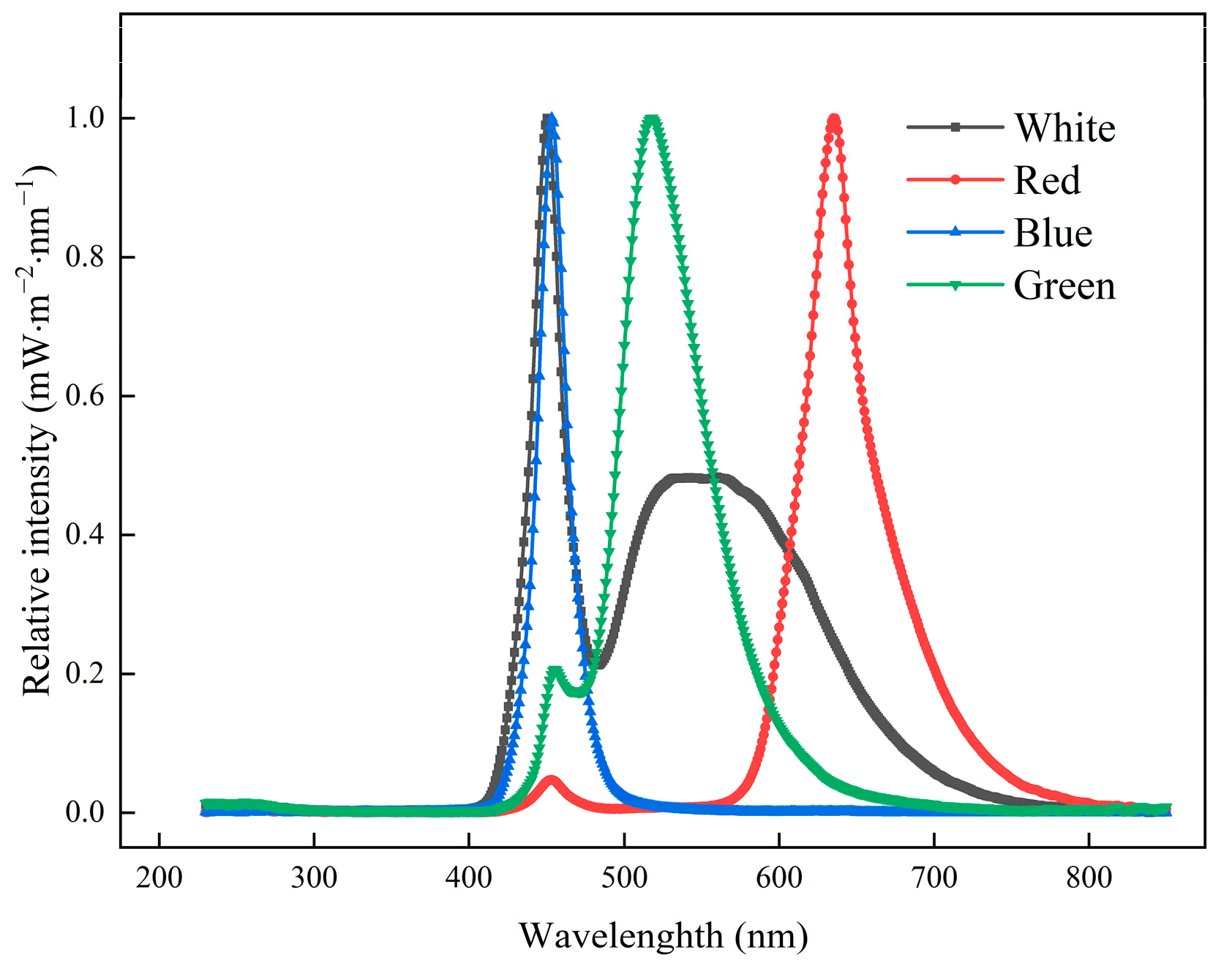

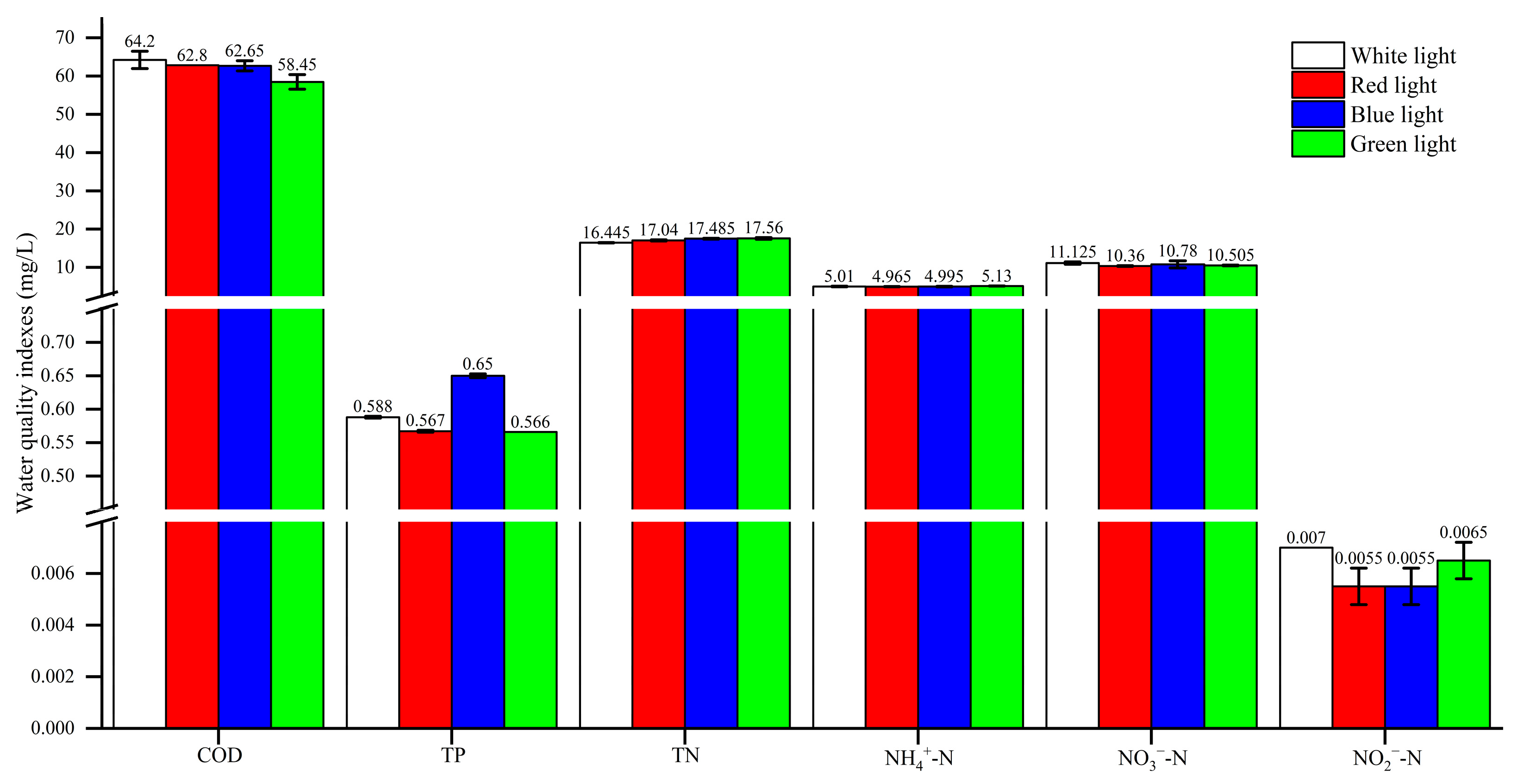
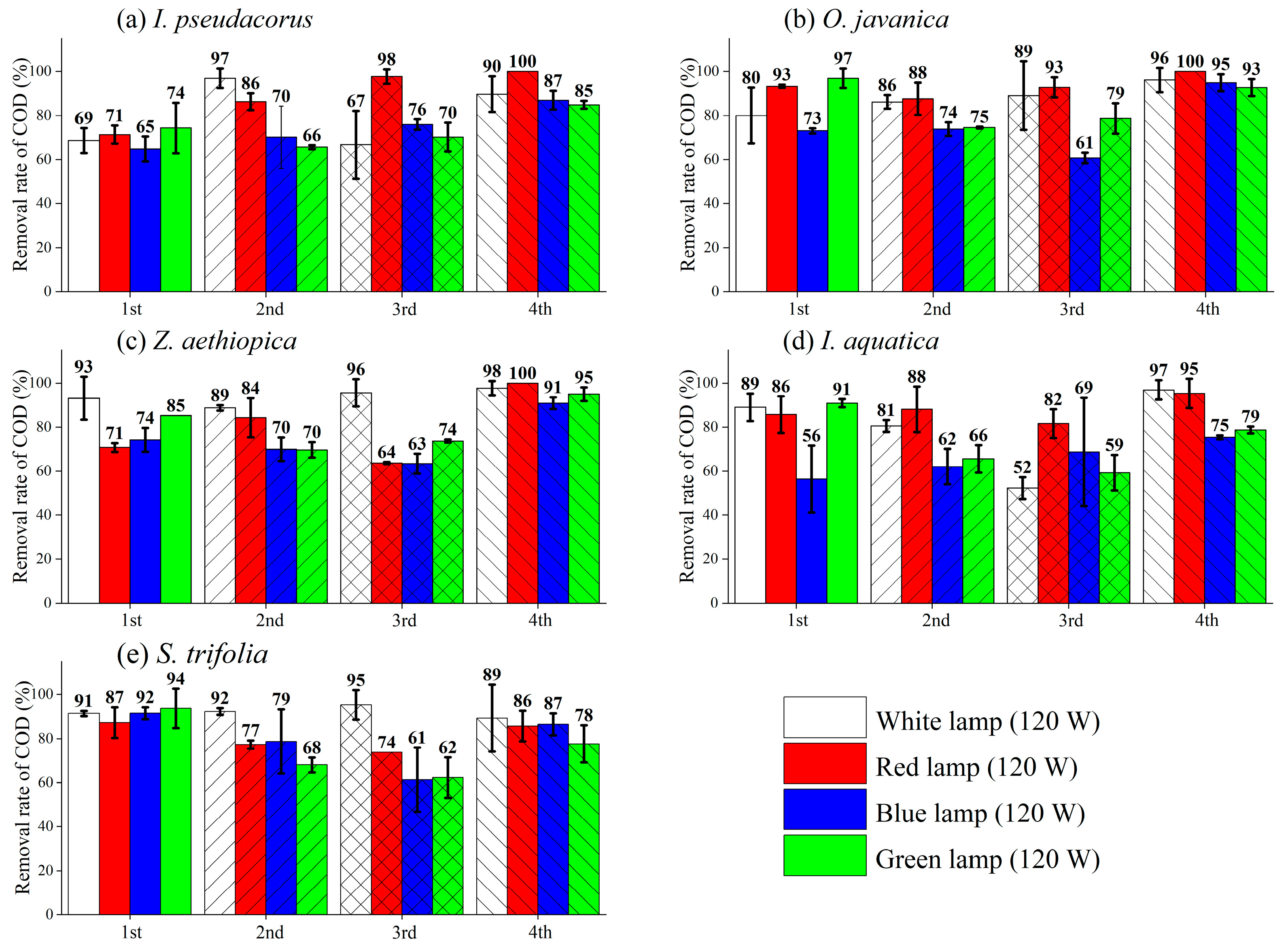

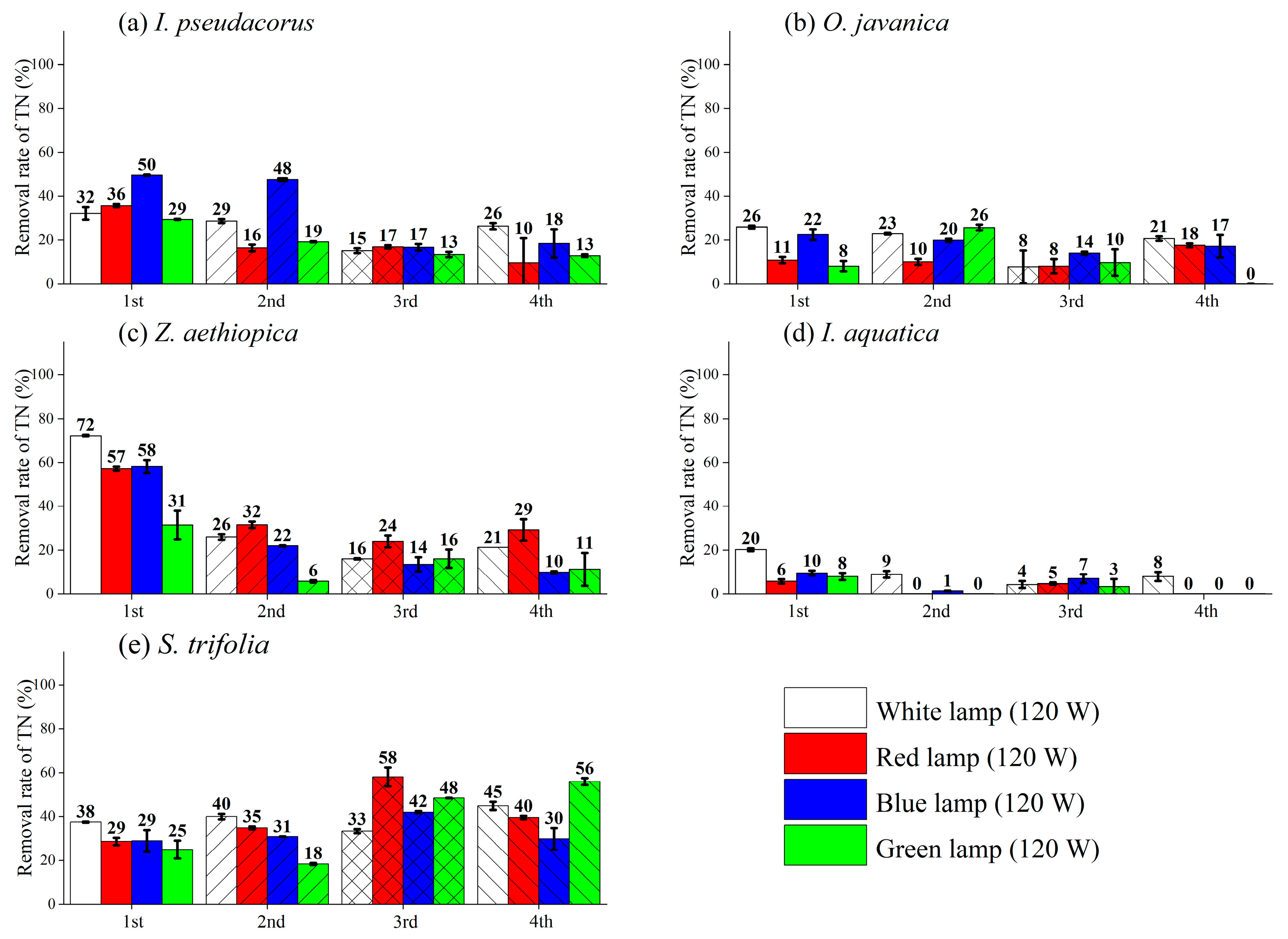


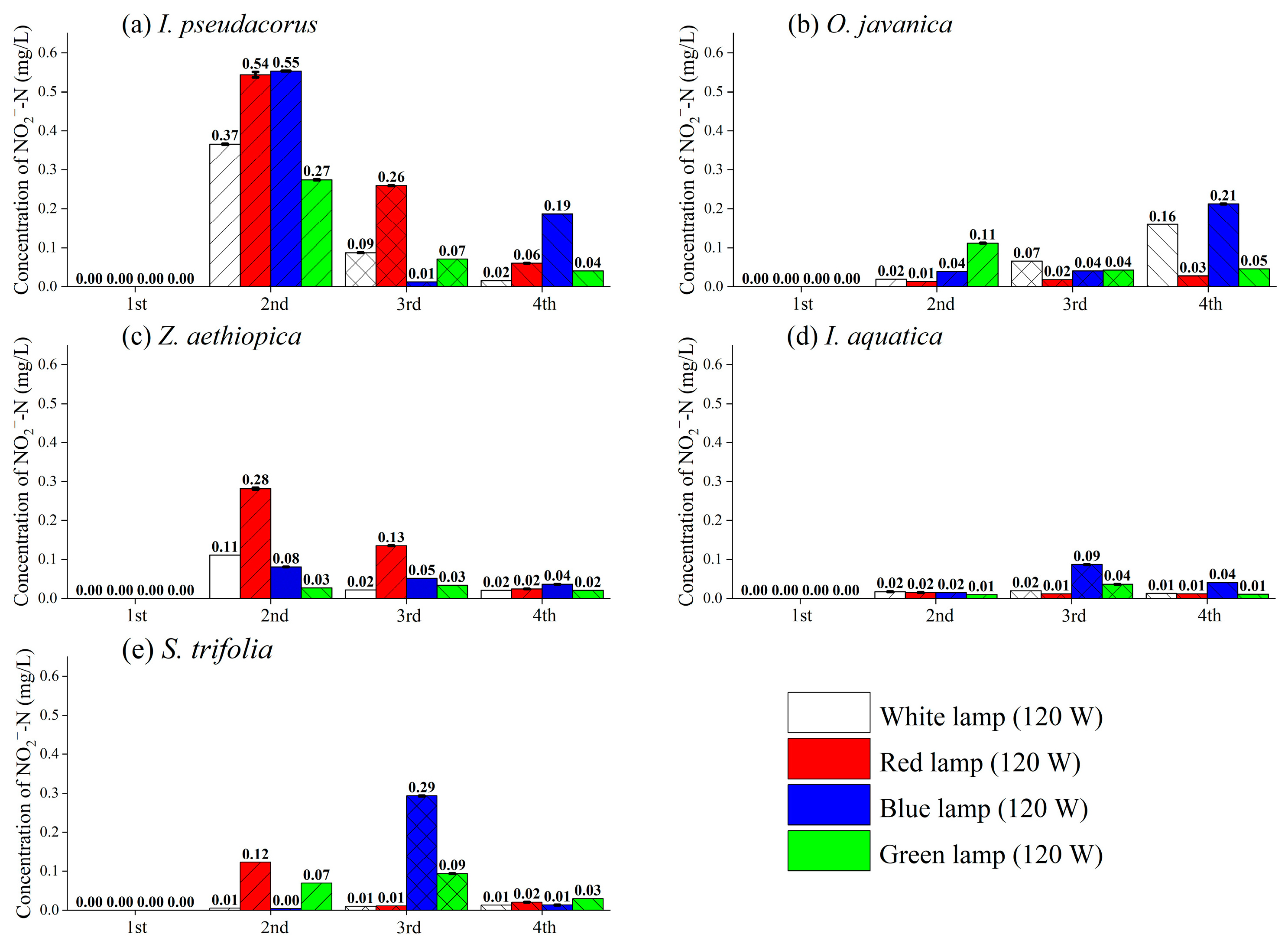

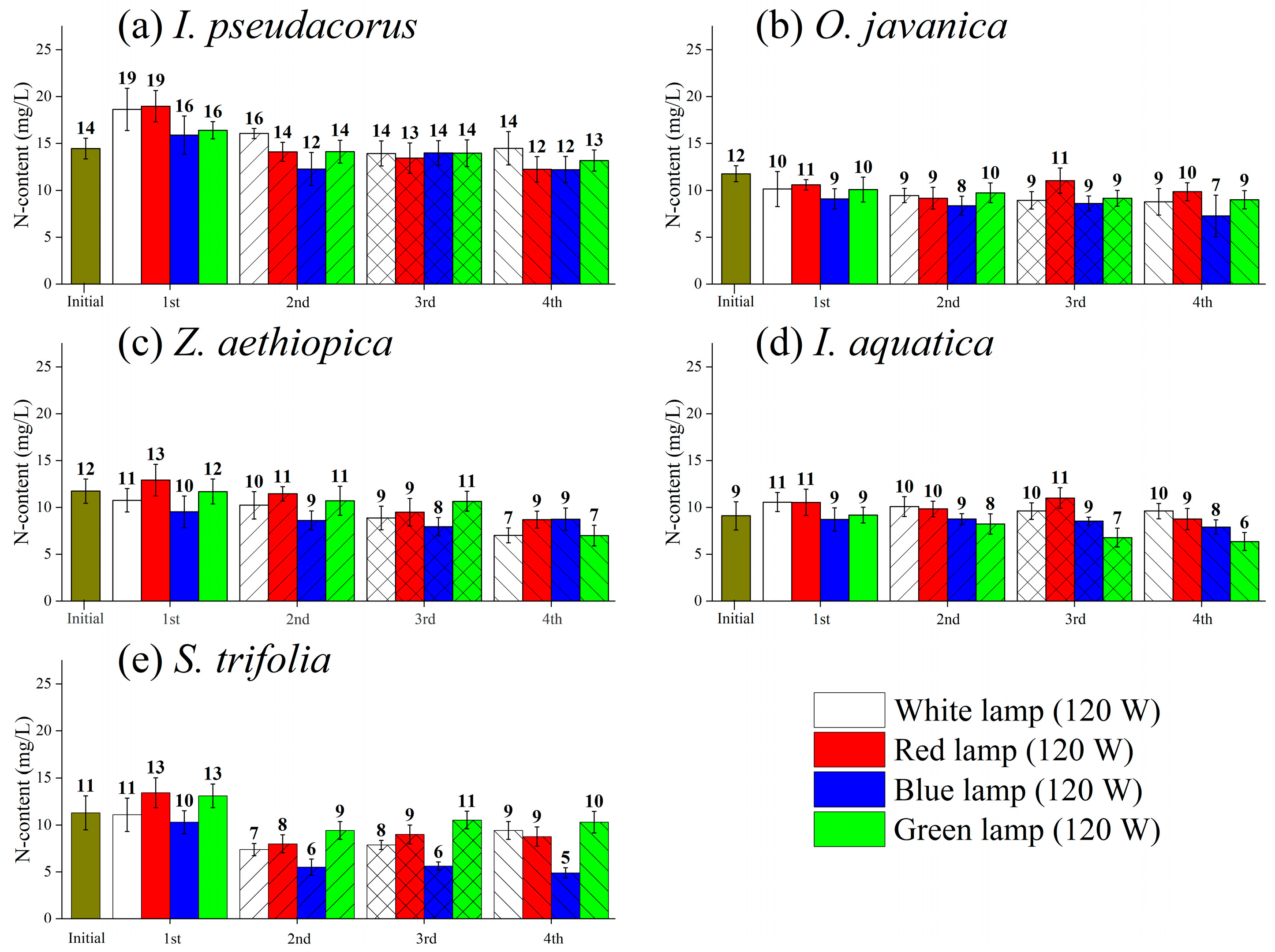

Disclaimer/Publisher’s Note: The statements, opinions and data contained in all publications are solely those of the individual author(s) and contributor(s) and not of MDPI and/or the editor(s). MDPI and/or the editor(s) disclaim responsibility for any injury to people or property resulting from any ideas, methods, instructions or products referred to in the content. |
© 2024 by the authors. Licensee MDPI, Basel, Switzerland. This article is an open access article distributed under the terms and conditions of the Creative Commons Attribution (CC BY) license (https://creativecommons.org/licenses/by/4.0/).
Share and Cite
Fan, L.; Zhang, X.; Li, Q.; Liu, Y.; Wang, H.; Zang, S. Removal of Nitrogen and Phosphorus in Low Polluted Wastewater by Aquatic Plants: Impact of Monochromatic Light Radiation. Water 2024, 16, 2002. https://doi.org/10.3390/w16142002
Fan L, Zhang X, Li Q, Liu Y, Wang H, Zang S. Removal of Nitrogen and Phosphorus in Low Polluted Wastewater by Aquatic Plants: Impact of Monochromatic Light Radiation. Water. 2024; 16(14):2002. https://doi.org/10.3390/w16142002
Chicago/Turabian StyleFan, Lingyun, Xujia Zhang, Qi Li, Yi Liu, Hanxi Wang, and Shuying Zang. 2024. "Removal of Nitrogen and Phosphorus in Low Polluted Wastewater by Aquatic Plants: Impact of Monochromatic Light Radiation" Water 16, no. 14: 2002. https://doi.org/10.3390/w16142002






